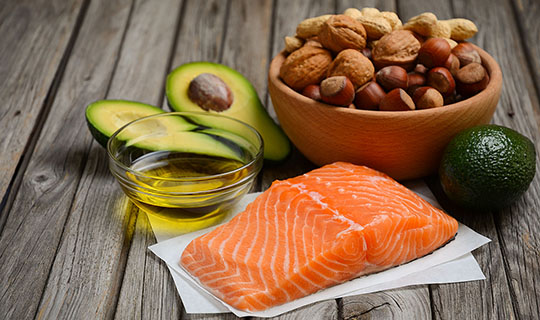
The word “fat” does not always have to be taboo. Rather, fat is vital to your health. True, different fats have varying effects on your health; there are good fats that offer great benefits to your health. Fats help regulate body temperature, hormone production, and protect our organs. Fat can also serve as a good source of energy, if consumed appropriately. Healthy fats include omega-3 fats and monounsaturated fats.
Below is a list of foods that fall under the healthy fat categories:
Omega-3 fatty acids are a kind of polyunsaturated fatty acid thought to help lower cholesterol and benefit heart health.
- Fatty fish – try to eat fatty fish like salmon, albacore tuna, sardines, lake trout, and mackerel twice a week.
- Walnuts
- Oils – you can replace solid fats like butter and margarine with oils like olive oil and avocado oil.
- Flaxseed – Add ground flaxseed to yogurts and baked goods or use flaxseed oil as salad dressing. Whole flaxseeds cannot be broken down by the body.
- Eggs – look for omega-3 labels on eggs at the grocery store.
Monounsaturated Fats are known to help blood cholesterol levels, which can help prevent heart disease.
- Nuts – Keep portion sizes in mind, as it’s easy to get carried away
- Oils – Stick to healthy oils like olive oil when cooking, baking or dressing salads
- Avocado – This versatile fruit can be used as a topping or spread on a wide variety of meals
- Peanut butter – About half of the fat in peanut butter is monounsaturated, and it’s found in the oil at the top of the jar so don’t pour it out; mix it in!
Fats to beware of:
Trans fats – Trans fats are heavily linked to heart disease. Manmade trans fats – usually in the form of partially hydrogenated oil – and are no longer recognized as safe by the FDA. Most fried foods contain trains fats, as well as a lot of baked goods and frozen foods. Stay away from stick margarines and spreads, frozen pizza, cookies, and fried foods – unless they specify that they are free of trans fats.
Fat-free and low-fat foods – Many packaged foods labeled fat-free or low-fat tend to have an unhealthy amount of added sugar, artificial flavors, and salt, which compensate for the loss of flavor from removing the fat. Therefore, you must read the nutrition label to see what other ingredients make up for the flavor in place of the fat. More often than not, it might be worth your while to stick to the regular fat food, just in small portions.
*References: Eatright.org, Fitness Journal